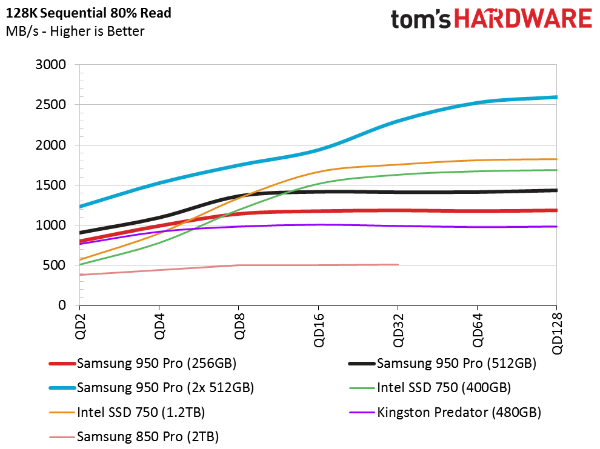Samsung 950 Pro SSD Review
NVMe in the M.2 form factor is finally a reality for desktop enthusiasts. Retailers begin selling Samsung's 950 Pro today, and we already have three drives in-hand.
Why you can trust Tom's Hardware
Mixed and Steady State Workload Performance
Our mixed workload testing is described in detail here, and our steady state tests are described here.
80% Read Mixed Workloads


Mixed workloads are particularly taxing. NVMe opens up the path to an SSD's flash by facilitating full-duplex data transfers, allowing the drive to read and write at the same time. SATA is half-duplex, so latency goes up fast when you start mixing reads and writes.
The 950 Pro's excellent sequential performance shines through in our mixed workload at low queue depths. It isn't until a queue depth of eight that Intel's SSD 750s overtake the 512GB 950 Pro in this sequential metric.
Samsung's 512GB 950 Pro impresses with its low queue depth random mixed workload performance. The Intel SSD 750s are faster when they're subjected to 100% random writes. However, when we mix the data, the big 950 Pro has a clear edge. Most enthusiasts will never push enough data to actually see the difference, though. Really, it makes more sense to focus on price and capacity when you're looking at this much performance.
Sequential Mixed Workloads in Steady State



The large drop-off in steady state sequential performance with an increase on the write side is called a bathtub curve. This relates to how mixed reads and writes tax SSD controllers. Some drives handle the duress better than others. Processors with more cores running at higher clock rates tend to fare better than those with mainstream-oriented specs.
Random Writes in Steady State


This is the first time we've been able to show how consistent random write performance correlates with consistent RAID performance. The black line shows a single 512GB 950 Pro. You can see how one drive's deviation doubles in a striped array. The trick is to minimize the differences between highs and lows, since they'll increase as drives are added.
The chart also shows how enabling RAID 0 through Intel's PCH can improve the storage subsystem's performance under heavy loads.
Get Tom's Hardware's best news and in-depth reviews, straight to your inbox.
The 950 Pro is a good candidate for client-level RAID 0, though it'd behave even better if we could get an optimized driver from Samsung.
Current page: Mixed and Steady State Workload Performance
Prev Page Initial Performance Results Next Page Real-World Workload Performance
Chris Ramseyer was a senior contributing editor for Tom's Hardware. He tested and reviewed consumer storage.
-
alidan you need to had a standard hdd to some of these, such as the gaming benchmark, as i want to say most of us dont have money for a ssd game drive, but a 4tb drive that can almost hold every game you own if you install everything, that's more readily available, apposed to the same price for 1/8th the space.Reply -
Larry Litmanen I always wondered why was M.2 designed to lay flat on the motherboard and not sideways like RAM. Wouldn't you save a lot more space on the mobo, plus if it is sideways you can easily find a spot for it on MITX boards.Reply
Also, if i have a modern motherboard (i have MSI Gaming 5, Z97) do i need to go into the BIOS and change something if i want to install this M.2 NVMe SSD.
I know you had to do something on older mobos when installing an SSD. -
Larry Litmanen Replyyou need to had a standard hdd to some of these, such as the gaming benchmark, as i want to say most of us dont have money for a ssd game drive, but a 4tb drive that can almost hold every game you own if you install everything, that's more readily available, apposed to the same price for 1/8th the space.
I game a lot and i have 850 Pro in 256 GB capacity. You don't really need that much space for games if you keep only 2-3 games installed at once. I play one game at a time, when i finish i just uninstall it. What's the point of saving it on PC if i will not play it again ever or at least for a while.
-
jtown80 alidan... no one wants reviews of standard Hard drives. Your behind the times if your still focusing on them and it is pointless to do benchmarks on them.Reply -
CRamseyer Hard drive performance barely even show up on the results when we show throughput performance. The reverse happens in the latency tests, the HDD lines are so long you can hardly see the NVMe performance.Reply -
rgd1101 Can you check the temp and power usage?Reply
Perform much better on the Z170 then on the Z97 reviewed at anandtech.com
Wonder how it perform on an AMD motherboard. -
tom10167 Very cool, I was/am excited for this. However the real world bencmarks say it all. Best case scenario 12 seconds on a 6 minute job is not much and many of those tests were showing half a second difference in performance. Nowhere near good enough for me. Still a nice step but I'll wait for cheaper m2 drives.Reply -
rgd1101 850 PRO EVO is cheaper. Wish they compare both 512GB m.2 and the SATA drive.Reply
Real world peformance probably close. -
arossetti I'm glad this form factor is starting to take off and is reasonably priced. Less cables and power connectors to muck up a build.Reply